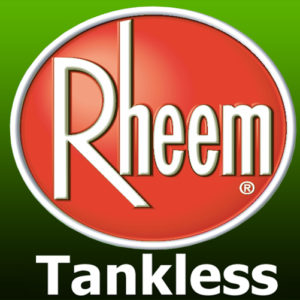First let’s look at how water heaters operate:
TANK STYLE WATER HEATER
Traditional tank-style gas water heaters utilize a continuous pilot flame to ignite the burner which in turn heats a metal tank with water inside. The temperature of the water is controlled by a thermostat that has a probe contacting the water inside the tank. Once the desired temperature is reached the thermostat shuts off the gas to the burner but NOT the pilot which remains ready for the next heating call. When hot water is drawn from a fixture it has to be replenished to the water heater tank. This is done by a cold water inlet pipe then conveyed to the bottom of the tank using a plastic pipe called a dip tube. The problem with this means of water heating is that it is very inefficient. Example: let’s say you have 40 gallons of 120-degree water in you tank ready for use, you decide to take a nice hot shower, as soon as you start running the hot water in your shower it is replaced with cold back to the tank to be heated now diminishing the 120-degree water inside the tank to the temperature of the incoming water. Depending on the flow rate of the fixture being used, the water heater will attempt to keep heating the water until the desired temperature is once again obtained. Complicating matters is when the water heater tank is dirty or has accumulated lime and calcium build-up which will hinder the heating times and efficiencies even further.
TANKLESS WATER HEATER
Tankless water heaters utilize an entirely different technology. A metal box the size of a suitcase hangs on the wall (inside or outside of the building) with a cold-water pipe inlet, a hot water pipe outlet, a gas pipe, and an electrical cord attached. Because there is no tank, tankless water heaters work “On Demand” meaning when you open a fixture flow through the water heater is detected and immediately lights a burner which heats the water flowing through the heat exchanger which is monitored by sensors that deliver the specified temperature requested. This all happens within 3 seconds from opening the fixture. Keep in mind, just like the tank-style water heater, the hot water still has to travel through the home’s piping system to get to the fixture calling for the hot water. The time it takes for the water to reach the calling fixture will vary from home to home. Delivery time can be controlled by a water circulation pump system.
Tankless water heater technology has been around since the early 1900s but was not economically feasible until the 1970s.

TANKLESS VS TANK WATER HEATERS- Pros and Cons
TANKLESS PROS :
- Energy Efficiency- only heat the water used, no energy wasted by heating water being stored.
- Endless Hot Water- never run out of hot water again. Great for large families with a lot of laundry, Large soaker bathtubs, showers with body sprays and multiple water features.
- Compact Design- Can be installed virtually anywhere, outdoors, indoors, crawl spaces, attics, basements. Space-saving.
- Easy Repair- Replace components or parts, not the entire unit.
- Longer Life Span- usually about 20 years
- Longer Warranty- Lifetime warranty on specific models, 12 years minimum on all models.
CONS:
- Higher Initial Costs- usually about 30% higher installation cost over tank-style water heaters.
- Gas Line Size- some tankless water heaters will require a ¾” and larger gas line.
- Flow Limitations- tankless water heaters are required to be “sized correctly” by a licensed plumbing contractor. If not sized appropriately some fixtures could have weak flow and water pressure.
- Hard Water- although not a direct tankless water heater problem, hard water can build up inside the unit causing various issues. Complete Plumbing always recommends a scale guard or even better a whole house water softening system
TANK STYLE PROS:
- Lower Installation Cost- approximately 30% less than tankless water heaters
- Water Storage- usually 40 to 50 gallons of water available in an emergency
- Availability- easily purchased at most home improvement stores
CONS:
- Eventually, Will Leak- the day will come- not if, but when your water heater tank will leak. When it does it can cause several hundred if not thousands of dollars in damages. Most insurance companies will NOT cover damages due to the age of the unit and the homeowner’s responsibility to maintain.
- Must be Elevated in a Garage- Plumbing code requires the burner assembly to be at least 18” off ground in a garage due to gasoline and other combustibles stored.
- Bulky and Heavy- Water weighs 8.33 pounds per gallon, making an average-sized water heater over 400 lbs sitting in a space of about 18”.
Must Be Strapped for Earthquake- On a stand, in the house or outside all tank-style water heaters in California must have earthquake bracing installed.







